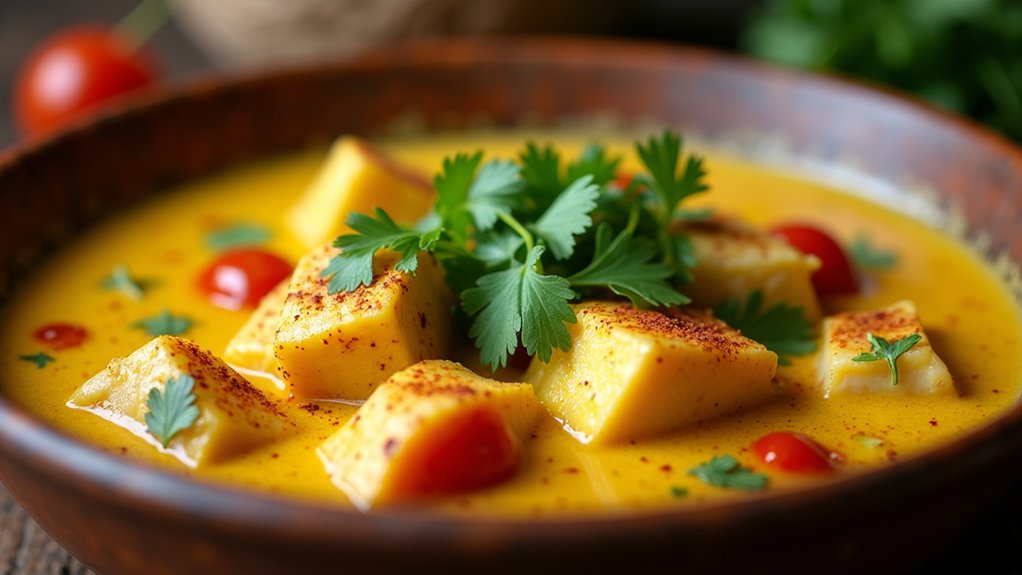Exploring coastal kitchens around the world has been a delightful adventure filled with diverse flavors and heartwarming stories. Each seafood stew I’ve encountered offers a unique taste of its region, from the fiery Creole gumbo to the fragrant Moroccan fish tagine. These recipes are more than just meals; they carry the essence of their origins. I’m excited to share these flavorful finds with you. Let’s uncover the secrets in these comforting bowls together.
Creole Gumbo With Andouille Sausage and Shrimp
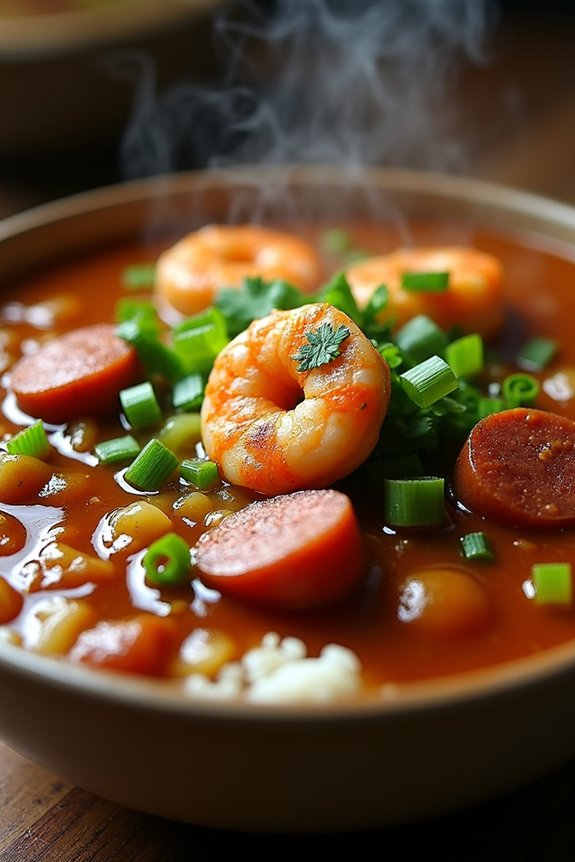
Creole Gumbo With Andouille Sausage and Shrimp is a classic southern dish that brings together the rich flavors of the Gulf Coast. This hearty stew is a perfect blend of spicy and savory, with the smokiness of Andouille sausage and the tender sweetness of shrimp complementing each other beautifully. Traditionally served over rice, this gumbo is a staple in Creole cuisine and is loved for its depth of flavor and comforting warmth.
The key to a good gumbo is in its roux—a mixture of fat and flour cooked together until it reaches a deep, rich brown color. This forms the base of the stew and gives it its characteristic flavor and texture. This recipe also includes the “holy trinity” of Creole cooking: onions, bell peppers, and celery, which provide a perfect aromatic foundation. With a touch of cayenne pepper for heat and the complex flavors of Creole seasoning, this dish is sure to transport your taste buds straight to Louisiana.
Ingredients: (Serves 4-6)
- 1/2 cup vegetable oil
- 1/2 cup all-purpose flour
- 1 large onion, diced
- 1 green bell pepper, diced
- 2 stalks celery, diced
- 3 cloves garlic, minced
- 1 pound Andouille sausage, sliced
- 1 pound shrimp, peeled and deveined
- 4 cups chicken broth
- 1 can (14.5 ounces) diced tomatoes
- 2 teaspoons Creole seasoning
- 1/2 teaspoon cayenne pepper (optional)
- 2 bay leaves
- Salt and black pepper to taste
- 1 tablespoon Worcestershire sauce
- 1 tablespoon hot sauce
- 1 bunch green onions, chopped
- Cooked white rice, for serving
- Fresh parsley, chopped, for garnish
Cooking Instructions:
- Prepare the Roux: In a large pot or Dutch oven, heat the vegetable oil over medium heat. Slowly add the flour, stirring constantly with a wooden spoon or whisk. Cook the roux until it reaches a deep, rich brown color, about 15-20 minutes. Be careful not to burn it, adjusting the heat as necessary.
- Add Vegetables: Stir in the diced onions, bell pepper, and celery (the holy trinity) into the roux. Cook for about 5 minutes until the vegetables are softened. Add the minced garlic and cook for another minute until fragrant.
- Incorporate Sausage: Add the sliced Andouille sausage to the pot and cook for about 5 minutes, allowing the sausage to brown slightly and release its flavors.
- Simmer the Gumbo: Pour in the chicken broth and diced tomatoes, stirring to combine. Add the Creole seasoning, cayenne pepper (if using), bay leaves, salt, and black pepper. Bring the mixture to a boil, then reduce the heat and let it simmer for about 30 minutes to allow the flavors to meld.
- Cook the Shrimp: Add the shrimp to the pot and continue to simmer for another 10 minutes, or until the shrimp are pink and cooked through.
- Season to Taste: Stir in the Worcestershire sauce, hot sauce, and half of the chopped green onions. Taste and adjust the seasoning with more salt, pepper, or hot sauce if desired.
- Serve: Remove the bay leaves and serve the gumbo hot over steamed white rice. Garnish with the remaining green onions and freshly chopped parsley for added freshness.
Extra Tips:
For an even deeper flavor, consider making the gumbo a day in advance as the flavors tend to develop and intensify overnight. If you prefer a thicker gumbo, you can simmer it longer or add a bit more flour to the roux.
Feel free to adjust the level of heat to your liking by increasing or decreasing the amount of cayenne pepper and hot sauce. Finally, always use fresh, good-quality shrimp and sausage for the best results.
Italian Brodetto Di Pesce
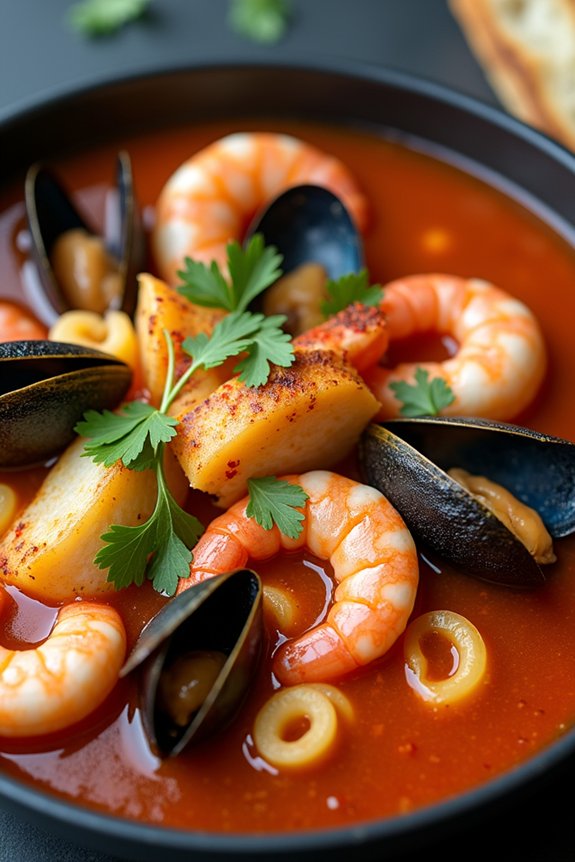
Brodetto di Pesce is a traditional Italian seafood stew that originates from the coastal regions of Italy, particularly in areas like Marche and Abruzzo. This dish highlights the fresh flavors of the sea and is typically made with a variety of fish and shellfish simmered in a rich, aromatic broth. The key to a great Brodetto di Pesce lies in the quality and freshness of the seafood.
It’s a comforting and hearty dish that’s perfect for family gatherings or a cozy dinner, bringing a taste of the Italian coast to your table.
This recipe serves 4-6 people and features a delightful combination of seafood, tomatoes, and herbs. It’s a versatile dish where you can use the seafood available to you, but a mixture of firm white fish, shrimp, mussels, and calamari is commonly used. The broth is enhanced with white wine, garlic, and fresh herbs, creating a savory base that complements the seafood beautifully.
Serve it with crusty bread to soak up the delicious broth, and enjoy a taste of Italy with every bite.
Ingredients:
- 1 pound firm white fish (such as cod or halibut), cut into chunks
- 1/2 pound shrimp, peeled and deveined
- 1/2 pound mussels, cleaned and debearded
- 1/2 pound calamari, cleaned and sliced into rings
- 1 onion, finely chopped
- 3 cloves garlic, minced
- 1 cup dry white wine
- 2 cups fish stock or clam juice
- 1 can (14 oz) crushed tomatoes
- 2 tablespoons olive oil
- 1 teaspoon red pepper flakes
- 1 teaspoon salt
- 1/2 teaspoon black pepper
- Fresh parsley, chopped, for garnish
- Lemon wedges, for serving
- Crusty bread, for serving
Cooking Instructions:
- Prepare the Base: In a large pot, heat the olive oil over medium heat. Add the chopped onion and cook until translucent, about 5 minutes. Stir in the minced garlic and red pepper flakes, cooking for another 1-2 minutes until fragrant.
- Add the Liquids: Pour in the white wine and bring it to a simmer, allowing the alcohol to evaporate for about 2 minutes. Stir in the crushed tomatoes, fish stock or clam juice, salt, and black pepper. Bring the mixture to a gentle boil.
- Simmer the Broth: Reduce the heat to low and let the broth simmer for about 15 minutes, allowing the flavors to meld together.
- Cook the Seafood: Add the fish chunks, shrimp, mussels, and calamari to the pot. Cover and cook for 5-7 minutes until the mussels have opened and the shrimp are pink and opaque. Discard any mussels that don’t open.
- Finish and Serve: Taste the stew and adjust the seasoning if necessary. Ladle the Brodetto di Pesce into bowls, garnish with fresh parsley, and serve with lemon wedges and crusty bread on the side.
Extra Tips:
For the best results, always use the freshest seafood you can find, as it greatly influences the flavor of the stew. If you’re using frozen seafood, make sure it’s completely thawed before cooking.
You can also customize the stew by adding other types of shellfish or fish according to your preference. Additionally, the stew can be made a few hours ahead of serving to allow the flavors to develop even further. Just be sure to reheat it gently to avoid overcooking the seafood.
Portuguese Caldeirada De Peixe
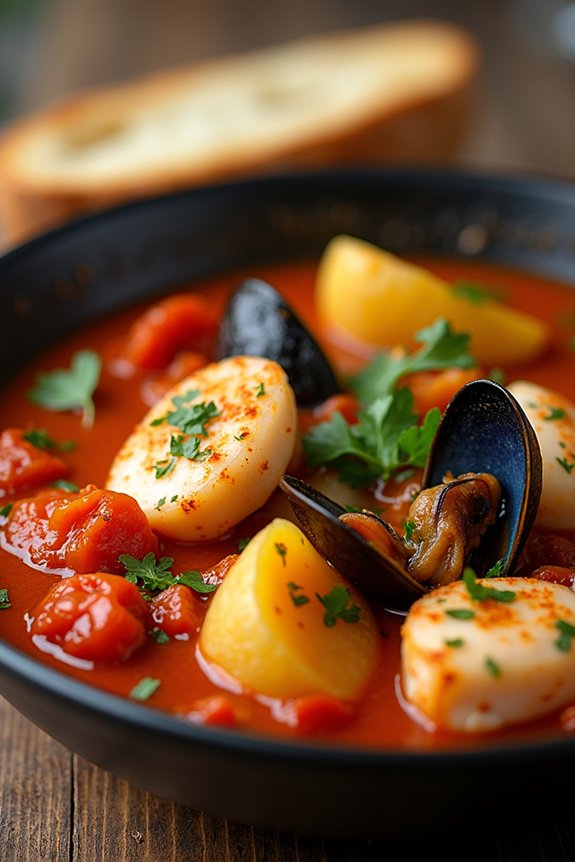
Portuguese Caldeirada De Peixe is a traditional seafood stew that embodies the flavors of the Portuguese coast. This dish is a harmonious blend of various types of fish and shellfish, simmered together with vegetables and aromatic herbs. The result is a hearty and flavorful stew that’s both comforting and satisfying.
Perfect for a family gathering or a cozy dinner, Caldeirada De Peixe is a demonstration of the rich culinary heritage of Portugal.
The beauty of this dish lies in its simplicity and adaptability, allowing you to use a variety of seafood depending on what’s fresh and available. Traditionally, the stew includes a mixture of white fish, shellfish, and sometimes even a bit of chorizo for an added layer of flavor. The stew is usually served with crusty bread to soak up the delicious broth, making it a complete and fulfilling meal.
Ingredients for 4-6 servings:
- 2 tablespoons olive oil
- 1 large onion, sliced
- 2 cloves garlic, minced
- 1 green bell pepper, sliced
- 1 red bell pepper, sliced
- 2 large tomatoes, chopped
- 2 teaspoons paprika
- 1 bay leaf
- Salt and pepper to taste
- 1 1/2 pounds of mixed fish (such as cod, haddock, or sea bass), cut into chunks
- 1/2 pound of mussels, cleaned
- 1/2 pound of clams, cleaned
- 1/2 pound of shrimp, peeled and deveined
- 4 medium potatoes, peeled and sliced
- 3 cups fish stock or water
- 1/2 cup white wine
- Fresh parsley, chopped for garnish
Cooking Instructions:
- Prepare the Vegetables: In a large pot, heat the olive oil over medium heat. Add the sliced onion and garlic, sautéing them until they turn translucent and fragrant, about 5 minutes.
- Add the Peppers and Tomatoes: Stir in the green and red bell peppers along with the chopped tomatoes. Cook for an additional 5 minutes until the peppers start to soften.
- Season the Base: Add the paprika, bay leaf, salt, and pepper to the vegetable mixture. Stir well to confirm the spices coat the vegetables evenly.
- Layer the Fish and Potatoes: Place the potato slices at the bottom of the pot, creating a layer. Arrange the chunks of fish on top, followed by the mussels, clams, and shrimp.
- Add Liquid and Simmer: Pour in the fish stock and white wine, making certain that the seafood and potatoes are submerged. Bring the mixture to a gentle simmer, cover the pot, and let it cook for about 20-25 minutes, or until the potatoes are tender and the seafood is cooked through.
- Check for Seasoning: Taste the stew and adjust the seasoning if necessary, adding more salt or pepper as desired.
- Garnish and Serve: Once the stew is ready, remove the bay leaf and discard it. Garnish the stew with chopped fresh parsley before serving. Enjoy the stew hot with crusty bread on the side.
Extra Tips:
When preparing Portuguese Caldeirada De Peixe, you can customize the seafood according to your preference or availability. Feel free to add other shellfish like squid or scallops for variety.
It’s also essential to clean the mussels and clams thoroughly to avoid any grit in the stew. If you prefer a thicker broth, you can mash a few pieces of the cooked potato into the liquid.
Finally, keep an eye on the cooking time to prevent overcooking the seafood, making sure it remains tender and flavorful.
French Bouillabaisse
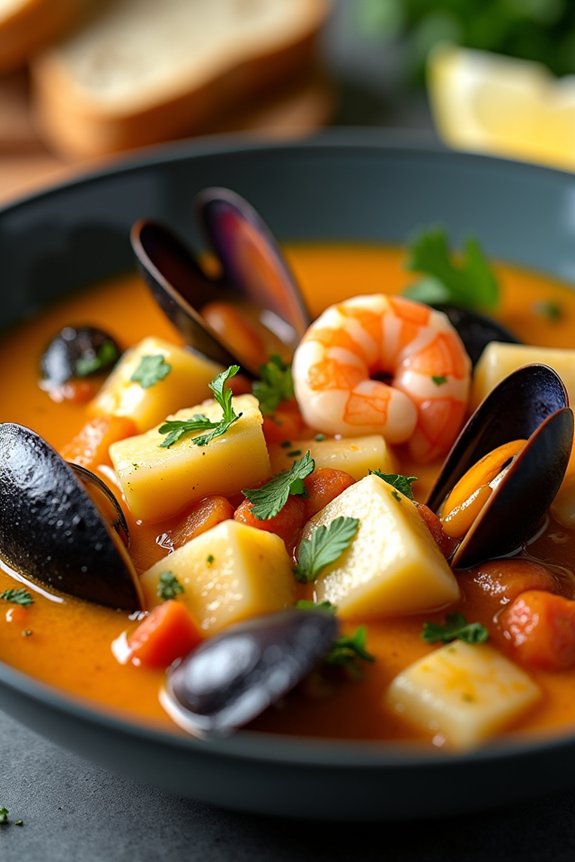
Bouillabaisse is a traditional Provençal fish stew originating from the port city of Marseille, France. This savory dish combines a variety of fresh fish and shellfish with aromatic herbs and spices, resulting in a rich and flavorful broth. The key to a successful bouillabaisse lies in the freshness of the seafood and the careful layering of flavors.
Typically served with crusty bread and rouille, a garlicky mayonnaise-like sauce, bouillabaisse is an experience that brings the essence of the Mediterranean to your table.
Preparing bouillabaisse is an art that involves simmering a blend of seafood with vegetables, herbs, and spices to create a deeply flavored broth. While traditional recipes can vary, they generally include a selection of white fish, shellfish, and fragrant herbs such as fennel, saffron, and thyme. The dish is typically made for larger gatherings, making it a perfect choice for a family meal or dinner party.
The following recipe provides instructions for preparing a French Bouillabaisse to serve 4-6 people.
Ingredients:
- 2 tablespoons olive oil
- 1 large onion, thinly sliced
- 2 leeks, white and light green parts only, thinly sliced
- 2 garlic cloves, minced
- 1 fennel bulb, thinly sliced
- 1 large tomato, chopped
- 1 teaspoon saffron threads
- 1 teaspoon dried thyme
- 1 bay leaf
- 1/2 teaspoon orange zest
- Salt and freshly ground black pepper, to taste
- 4 cups fish stock
- 1 1/2 pounds mixed white fish fillets (such as cod, snapper, or halibut), cut into chunks
- 1 pound mussels, cleaned and debearded
- 1 pound clams, cleaned
- 1/2 pound large shrimp, peeled and deveined
- 1/2 cup dry white wine
- Chopped fresh parsley, for garnish
- Lemon wedges, for serving
- Crusty bread, for serving
- Rouille, for serving
Instructions:
- Prepare the Aromatics: Heat the olive oil in a large, heavy pot over medium heat. Add the onion, leeks, garlic, and fennel. Cook until the vegetables are softened but not browned, about 5-7 minutes.
- Add Tomatoes and Seasonings: Stir in the chopped tomato, saffron threads, thyme, bay leaf, orange zest, salt, and pepper. Cook for another 2 minutes until fragrant.
- Simmer the Broth: Pour in the fish stock and white wine. Bring the mixture to a boil, then reduce the heat to a gentle simmer. Let it cook uncovered for about 15 minutes, allowing the flavors to meld together.
- Cook the Seafood: Add the fish chunks to the pot, followed by the mussels, clams, and shrimp. Cover the pot and cook for about 5-7 minutes, or until the fish is cooked through and the shellfish have opened. Discard any shellfish that don’t open.
- Final Touches: Taste the broth and adjust the seasoning with salt and pepper as needed. Remove the bay leaf before serving.
- Serve: Ladle the bouillabaisse into bowls, ensuring each serving gets a variety of seafood. Garnish with fresh parsley and serve with lemon wedges, crusty bread, and a dollop of rouille on the side.
Extra Tips:
For the best bouillabaisse, always use the freshest seafood available. The dish is highly adaptable, so feel free to use whatever fish and shellfish are freshest at your market.
Preparing the rouille in advance will save time when serving. If saffron is unavailable, substitute turmeric for a similar color, though it will alter the flavor slightly.
Remember to clean the shellfish thoroughly to avoid any grit in the dish. Enjoy the process of layering flavors, and don’t rush the simmering step, as it’s essential to developing the depth of flavor in the broth.
Spanish Zarzuela De Mariscos
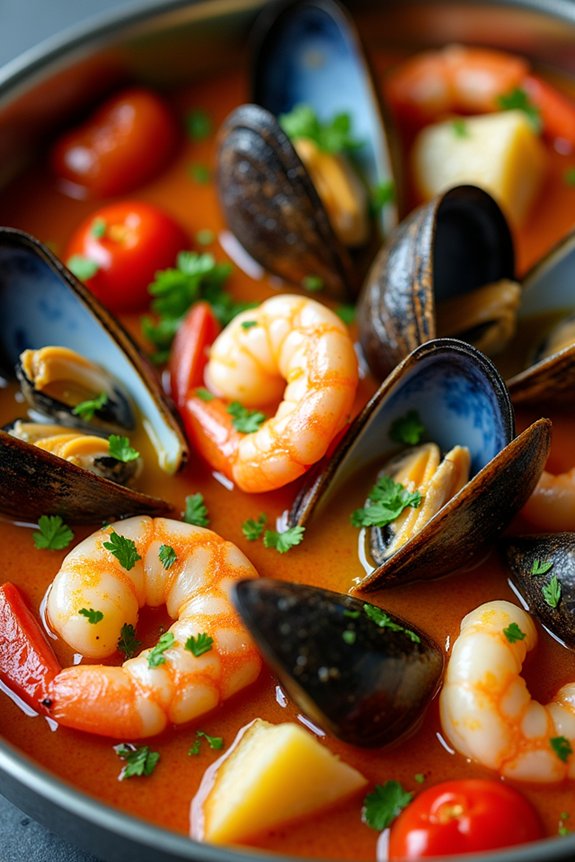
Zarzuela De Mariscos is a delightful Spanish seafood stew that hails from the Catalonia region. This dish is a symphony of flavors, with an assortment of fresh seafood simmered in a rich, aromatic broth made with tomatoes, white wine, and saffron. The name “zarzuela” translates to “operetta” in Spanish, signifying the dish’s complexity and harmonious blend of ingredients.
It’s a perfect centerpiece for a family gathering or a special occasion, bringing the taste of the Mediterranean to your table.
This recipe serves 4-6 people and is perfect for those who appreciate the bounty of the sea. The combination of seafood such as mussels, clams, shrimp, and fish, cooked with a medley of vegetables and spices, creates a robust and flavorful stew. Whether you’re familiar with Spanish cuisine or trying it for the first time, Zarzuela De Mariscos is sure to impress with its vibrant colors and rich taste.
Ingredients:
- 1 pound fresh mussels
- 1 pound fresh clams
- 1 pound large shrimp, peeled and deveined
- 1 pound firm white fish (such as monkfish or cod), cut into chunks
- 1/4 cup olive oil
- 1 onion, finely chopped
- 3 cloves garlic, minced
- 1 red bell pepper, diced
- 1 green bell pepper, diced
- 2 ripe tomatoes, peeled and chopped
- 1/2 cup dry white wine
- 2 cups fish stock
- 1 pinch saffron threads
- 1 teaspoon smoked paprika
- Salt and pepper to taste
- 2 tablespoons chopped fresh parsley
- Lemon wedges for serving
Cooking Instructions:
- Prepare the Seafood: Begin by scrubbing the mussels and clams under cold running water to remove any debris. Discard any that are open and don’t close when tapped. Set aside the cleaned seafood.
- Sauté the Aromatics: In a large, heavy pot or Dutch oven, heat the olive oil over medium heat. Add the chopped onion, garlic, red bell pepper, and green bell pepper. Sauté for about 5-7 minutes until the vegetables are softened and fragrant.
- Add Tomatoes and Spices: Stir in the chopped tomatoes, saffron threads, and smoked paprika. Cook for another 3-4 minutes until the tomatoes begin to break down and release their juices.
- Deglaze with Wine: Pour in the white wine, scraping up any brown bits from the bottom of the pot. Let it simmer for a couple of minutes to allow the alcohol to evaporate.
- Simmer the Broth: Add the fish stock to the pot, and bring the mixture to a gentle simmer. Season with salt and pepper to taste.
- Cook the Seafood: Gently add the mussels, clams, shrimp, and fish chunks into the pot. Cover and let the stew simmer for about 10 minutes, or until the mussels and clams have opened, and the shrimp are pink and opaque. Discard any mussels or clams that remain closed.
- Finish and Serve: Sprinkle the stew with chopped fresh parsley and serve hot with lemon wedges on the side for squeezing over the top.
Extra Tips:
For the best results, use the freshest seafood you can find, as the quality of the seafood greatly impacts the flavor of the dish.
If you prefer a thicker stew, you can mash some of the cooked tomatoes against the side of the pot before adding the seafood.
Serve Zarzuela De Mariscos with crusty bread to soak up the delicious broth, and consider pairing it with a crisp white wine like Albariño for a truly authentic Spanish dining experience.
Thai Tom Yum Goong
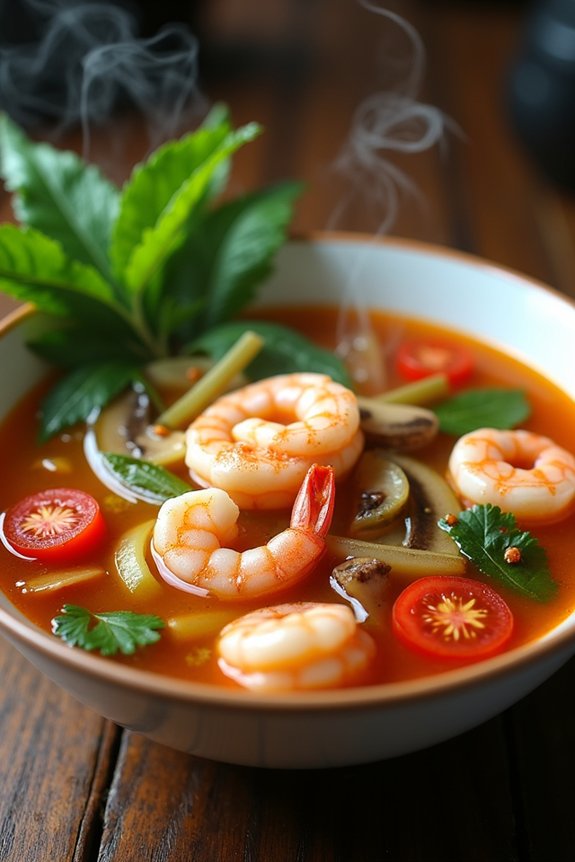
Thai Tom Yum Goong is a quintessential Thai dish that embodies the perfect balance of spicy, sour, salty, and sweet flavors. This iconic seafood stew is known for its aromatic broth, which is infused with lemongrass, galangal, and kaffir lime leaves, creating a fragrant base that complements the tender shrimp.
Tom Yum Goong isn’t only a culinary delight but also a comforting dish that can warm you up on a chilly day. Traditionally served with jasmine rice, it makes for a complete and satisfying meal.
This seafood stew is a favorite among Thai cuisine enthusiasts due to its vibrant flavors and relatively straightforward preparation. The key to a successful Tom Yum Goong lies in using fresh ingredients, particularly the shrimp and herbs, to create a broth that’s both rich and invigorating.
While some variations of the recipe include the addition of coconut milk for a creamier texture, the classic version relies solely on a clear broth. Whether you’re a seasoned chef or a beginner in the kitchen, this recipe offers a step-by-step guide to making Tom Yum Goong that will transport your taste buds straight to Thailand.
Ingredients (Serves 4-6)
- 1 lb (450g) fresh shrimp, peeled and deveined
- 4 cups (1 liter) chicken or seafood stock
- 2 stalks lemongrass, cut into 1-inch pieces and smashed
- 3-4 slices fresh galangal
- 3-4 kaffir lime leaves, torn into pieces
- 2-3 Thai bird’s eye chilies, crushed
- 1 medium onion, sliced
- 1 cup (150g) button mushrooms, sliced
- 2 medium tomatoes, quartered
- 3 tablespoons fish sauce
- 1 tablespoon lime juice
- 1 teaspoon sugar
- Fresh cilantro leaves for garnish
- Optional: 1-2 tablespoons Thai chili paste (Nam Prik Pao) for added spice and flavor
Cooking Instructions
- Prepare the Broth: In a large pot, bring the chicken or seafood stock to a gentle boil over medium heat. Add the lemongrass, galangal, and kaffir lime leaves. Let the broth simmer for about 5-7 minutes to allow the flavors to infuse.
- Add Vegetables and Aromatics: Add the crushed Thai chilies, sliced onion, mushrooms, and tomatoes to the pot. Continue to simmer for another 5 minutes, allowing the vegetables to cook and release their flavors into the broth.
- Cook the Shrimp: Add the shrimp to the pot and cook until they turn pink and opaque, which should take about 3-4 minutes. Be careful not to overcook the shrimp, as they can become tough and rubbery.
- Season the Soup: Stir in the fish sauce, lime juice, and sugar. Taste and adjust the seasoning as needed, balancing the flavors of salty, sour, and sweet to your preference. If you prefer a spicier broth, add the Thai chili paste at this stage.
- Final Touches: Remove the pot from heat and discard the lemongrass, galangal slices, and kaffir lime leaves. These ingredients aren’t meant to be eaten but are essential for flavoring the broth.
- Serve: Ladle the hot Tom Yum Goong into bowls and garnish with fresh cilantro leaves. Serve immediately with steamed jasmine rice on the side for a complete meal.
Extra Tips
When making Tom Yum Goong, freshness is key, particularly for the herbs and seafood. If possible, purchase shrimp that haven’t been frozen to maintain their texture and flavor.
Additionally, adjusting the level of chili peppers allows you to control the spiciness to suit your taste. For an extra layer of flavor, consider briefly toasting the lemongrass and galangal in a dry pan before adding them to the broth. This can enhance their aromatic qualities, resulting in an even more flavorful stew.
Brazilian Moqueca Baiana
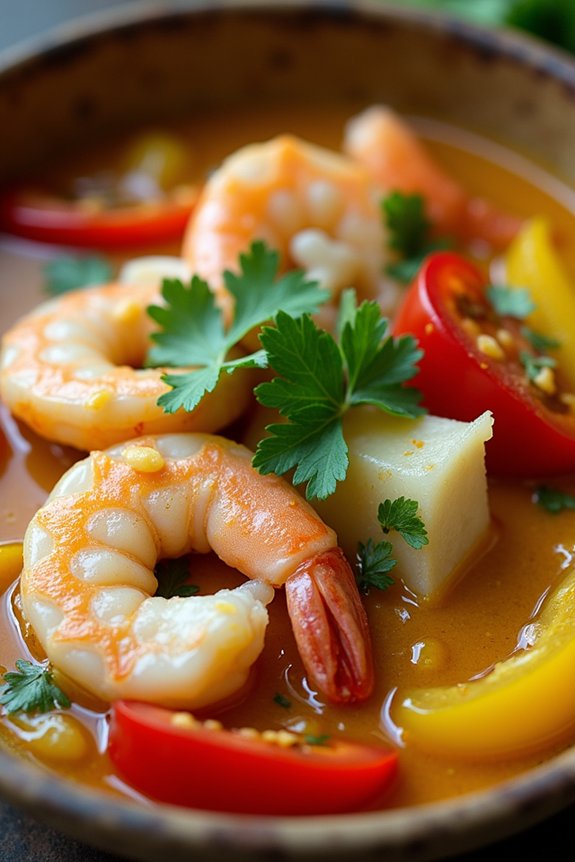
Moqueca Baiana is a traditional Brazilian seafood stew hailing from the state of Bahia. This vibrant and aromatic dish is a celebration of flavors, featuring a rich combination of coconut milk, dendê oil (red palm oil), and a medley of fresh seafood. The stew is often prepared with a variety of fish and shellfish, simmered with bell peppers, tomatoes, onions, and cilantro, creating a harmony of tastes that’s both comforting and exotic.
Moqueca Baiana is typically served with rice and farofa, offering a complete and satisfying meal that brings the coastal flavors of Brazil to your table. This delightful stew isn’t only a reflection of Brazil’s diverse culinary heritage but also a demonstration of the influence of African, Portuguese, and indigenous cuisines. The use of dendê oil is a nod to the African influence, while the coconut milk and seafood highlight the country’s extensive coastline.
Moqueca Baiana is a dish that brings people together, perfect for family gatherings or special occasions, and its colorful presentation makes it an inviting centerpiece for any meal. Whether you’re a seafood lover or new to Brazilian cuisine, this stew is sure to impress with its depth of flavor and aromatic spices.
Ingredients (Serves 4-6):
- 2 pounds of firm white fish fillets (such as snapper or cod)
- 1 pound of shrimp, peeled and deveined
- 2 tablespoons of lime juice
- 4 cloves of garlic, minced
- Salt and black pepper to taste
- 2 tablespoons of dendê oil (red palm oil)
- 1 large onion, sliced
- 1 red bell pepper, sliced
- 1 yellow bell pepper, sliced
- 2 large tomatoes, chopped
- 1 cup of coconut milk
- 1/4 cup of fresh cilantro, chopped
- 1/4 cup of fresh parsley, chopped
- Cooked white rice, for serving
Cooking Instructions:
- Marinate the Seafood: In a large bowl, combine the fish fillets and shrimp with lime juice, minced garlic, salt, and black pepper. Mix well to make sure the seafood is evenly coated. Cover and refrigerate for at least 30 minutes to allow the flavors to meld.
- Prepare the Stew Base: In a large pot or Dutch oven, heat the dendê oil over medium heat. Add the sliced onion, red bell pepper, and yellow bell pepper. Sauté until the vegetables are softened and the onion is translucent, about 5-7 minutes.
- Cook the Tomatoes: Add the chopped tomatoes to the pot and cook for another 5 minutes, stirring occasionally until they begin to break down and release their juices.
- Add Coconut Milk: Pour in the coconut milk and bring the mixture to a gentle simmer. Allow the stew base to cook for an additional 5 minutes, letting the flavors blend together.
- Simmer the Seafood: Gently add the marinated fish fillets and shrimp to the pot. Cover and let the stew simmer for 15-20 minutes or until the fish is cooked through and the shrimp are pink and opaque.
- Finish with Herbs: Stir in the fresh cilantro and parsley just before serving, reserving a little for garnish.
- Serve: Ladle the Moqueca Baiana into bowls and garnish with the remaining cilantro and parsley. Serve hot with cooked white rice on the side.
Extra Tips:
When preparing Moqueca Baiana, it’s important to use fresh seafood to enhance the flavor of the stew. If dendê oil is unavailable, you may substitute it with olive oil, although the flavor will be slightly different.
For an added kick, consider including a small chili pepper in the stew base. Adjust the seasoning to your taste, and feel free to experiment with different types of seafood to personalize the dish. Remember, the key to a perfect Moqueca Baiana is balancing the rich coconut milk with the tangy lime and aromatic herbs, creating a deliciously satisfying experience.
Japanese Nabe Seafood Hotpot
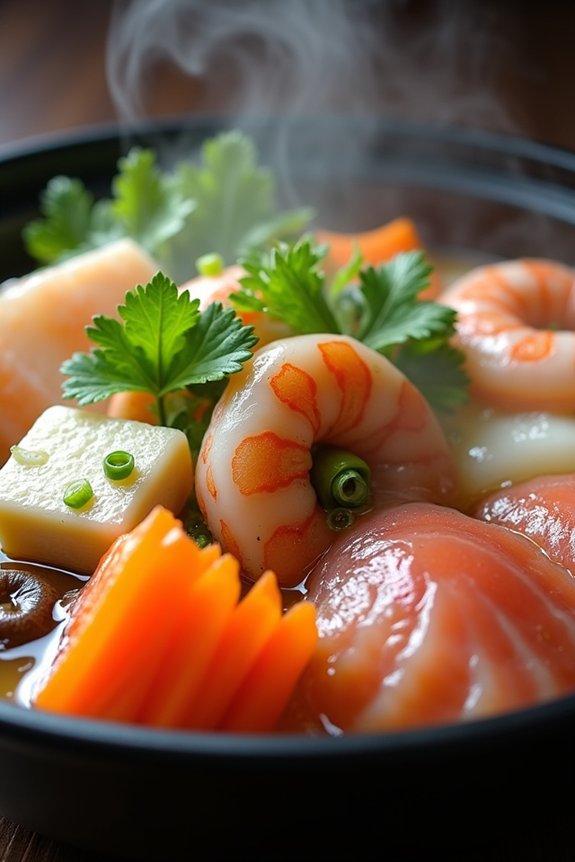
Japanese Nabe is a traditional hotpot dish enjoyed especially during the colder months. It’s a communal meal, where everyone gathers around a simmering pot, sharing not just food but warmth and camaraderie.
The Nabe hotpot is versatile, allowing various ingredients to be added based on regional preferences or what’s available, but our focus here is on the seafood variant. This seafood hotpot is bursting with flavors from the ocean, complemented by the umami-rich broth and fresh vegetables. Perfect for a cozy dinner with family or friends, this dish is both nourishing and fulfilling.
Nabe is relatively easy to prepare, and it provides a hearty meal that’s both nutritious and satisfying. The key to a good Nabe is the broth, which serves as the base for the entire dish. For our seafood Nabe, the broth is infused with the essence of kombu (dried kelp), giving it a deep umami flavor, while the seafood adds a delicate sweetness. Fresh vegetables such as napa cabbage, shiitake mushrooms, and daikon radish add texture and balance to the richness of the seafood.
Ingredients for 4-6 servings:
- 1 piece kombu (dried kelp)
- 8 cups water
- 1/4 cup soy sauce
- 1/4 cup mirin (sweet rice wine)
- 1 tablespoon sake (Japanese rice wine)
- 1 teaspoon salt
- 250g salmon fillet, cut into chunks
- 200g firm white fish (such as cod), cut into chunks
- 200g shrimp, peeled and deveined
- 200g scallops
- 1 block firm tofu, cut into cubes
- 1 small head napa cabbage, chopped
- 1 carrot, sliced thinly
- 6 shiitake mushrooms, stems removed
- 1 small daikon radish, sliced thinly
- 2 green onions, chopped
- Fresh cilantro for garnish
Cooking Instructions:
- Prepare the Broth: Place the kombu in a large pot with 8 cups of water. Let it soak for about 20 minutes to infuse the water with its flavor. After soaking, place the pot over medium heat and bring to a gentle simmer. Remove the kombu just before the water starts to boil.
- Season the Broth: Add soy sauce, mirin, sake, and salt to the pot. Stir well to combine and adjust the seasoning to taste. Allow the broth to simmer gently for about 5 minutes to let the flavors meld together.
- Prepare the Seafood and Vegetables: While the broth is simmering, prepare the seafood and vegetables. Make sure all the seafood is clean and cut into bite-sized pieces. Chop the vegetables and tofu into manageable pieces for easy eating.
- Cook the Ingredients: Add the salmon, white fish, shrimp, scallops, tofu, napa cabbage, carrot, shiitake mushrooms, and daikon radish into the simmering broth. Allow the ingredients to cook for about 10 minutes, or until the seafood is opaque and cooked through, and the vegetables are tender.
- Garnish and Serve: Once cooked, sprinkle chopped green onions and fresh cilantro over the top. Serve the Nabe directly from the pot, allowing everyone to help themselves to the various ingredients and broth.
Extra Tips:
When making Nabe, it’s important to maintain a gentle simmer rather than a rolling boil to prevent the seafood from becoming tough and overcooked.
Consider adding other ingredients such as udon noodles or glass noodles to make the dish even heartier. If you prefer a spicier kick, a bit of chili paste or sliced fresh chili can be added to the broth.
Caribbean Callaloo With Crab and Shrimp
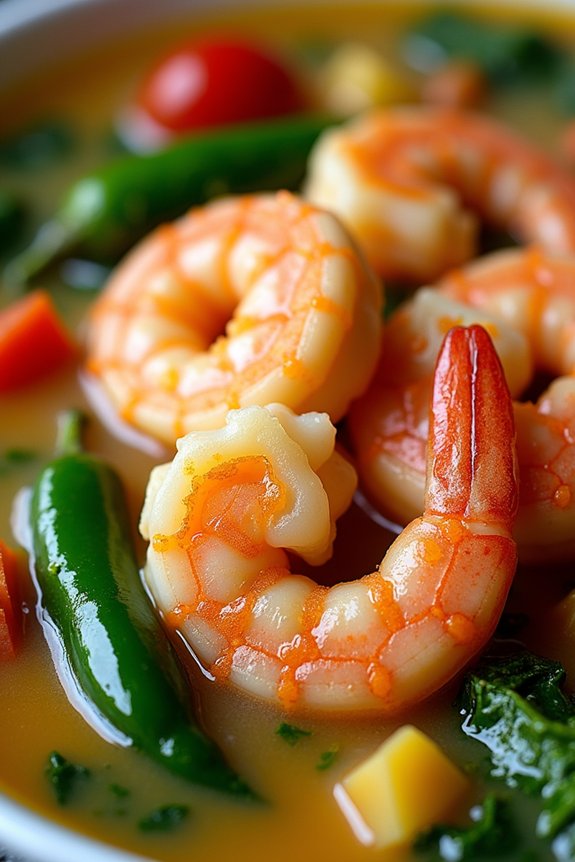
Caribbean Callaloo With Crab and Shrimp is a vibrant and flavorful seafood stew that beautifully captures the essence of Caribbean cuisine. This hearty dish combines the rich flavors of crab and shrimp with a medley of fresh vegetables and aromatic spices.
Callaloo, a popular Caribbean leafy green, forms the base of this stew, providing a unique taste and texture that perfectly complements the seafood. The dish isn’t only delicious but also visually appealing with its colorful array of ingredients.
Traditionally served at family gatherings and special occasions, this dish brings a taste of the Caribbean to your dining table. The combination of tender crab and succulent shrimp in a creamy coconut milk broth makes it an irresistible treat for seafood lovers.
While the preparation may seem complex, following these straightforward steps will help you create an authentic Caribbean Callaloo With Crab and Shrimp that serves 4-6 people.
Ingredients:
- 1 pound of fresh crab meat
- 1 pound of shrimp, peeled and deveined
- 1 bunch of fresh callaloo leaves or spinach
- 1 onion, finely chopped
- 2 cloves of garlic, minced
- 1 bell pepper, diced
- 2 tomatoes, chopped
- 1 scotch bonnet pepper, whole
- 1 can (13.5 oz) of coconut milk
- 2 cups of vegetable or chicken broth
- 1 tablespoon of olive oil
- 1 teaspoon of thyme
- Salt and pepper to taste
- Juice of 1 lime
Cooking Instructions:
- Prepare the Ingredients: Begin by thoroughly washing the callaloo leaves or spinach. Trim any tough stems and chop the leaves into bite-sized pieces. Set aside. In a large pot, heat the olive oil over medium heat.
- Sauté Aromatics: Add the chopped onion, garlic, and bell pepper to the pot. Sauté for about 3-4 minutes until the onion becomes translucent and the mixture is fragrant.
- Cook the Base: Stir in the chopped tomatoes and whole scotch bonnet pepper. Cook for another 2 minutes until the tomatoes begin to break down, releasing their juices.
- Add Liquids and Seasoning: Pour in the coconut milk and vegetable or chicken broth. Add the thyme, and season with salt and pepper to taste. Bring the mixture to a gentle simmer.
- Incorporate Callaloo and Seafood: Once the broth is simmering, mix in the prepared callaloo leaves. Allow them to wilt slightly before adding the crab meat and shrimp. Stir gently to combine.
- Simmer the Stew: Cover the pot and let the stew simmer for about 15-20 minutes, or until the shrimp are fully cooked and the flavors have melded together. Stir occasionally to prevent sticking.
- Finalize the Dish: Remove the whole scotch bonnet pepper before serving. Squeeze the juice of one lime into the stew and give it a final stir.
Extra Tips:
For an even richer flavor, you can use fresh coconut milk. Adjust the heat level by either removing the seeds from the scotch bonnet pepper or replacing it with a milder pepper if you prefer a less spicy stew.
Serve the dish with rice or bread to soak up the delicious broth. If callaloo is difficult to find, spinach or Swiss chard can be a suitable substitute.
Finally, confirm that the crab meat is fresh or properly thawed if using frozen, to maintain the quality of the stew.
New England Clam Chowder

New England Clam Chowder is a classic American dish that has been enjoyed by seafood lovers for generations. This hearty stew is rich and creamy, featuring tender clams, potatoes, and a luscious broth that perfectly balances the flavors of the sea. Originating from the northeastern United States, this clam chowder is a staple in many coastal homes and is known for its comforting and satisfying qualities.
Whether served as a starter or a main course, New England Clam Chowder is a dish that brings warmth and a taste of the ocean to your table.
To create an authentic New England Clam Chowder, it’s crucial to use fresh ingredients and follow traditional techniques. The key to a good chowder is a creamy base made with milk or cream, which is thickened with a roux or potatoes. The addition of bacon or salt pork adds depth and smokiness, complementing the sweet and briny clams.
By carefully selecting the right clams and seasoning the chowder to perfection, you can recreate this iconic dish in your own kitchen. Here’s a recipe that serves 4-6 people, allowing you to share this delightful stew with family and friends.
Ingredients:
- 4 dozen fresh clams (littleneck or cherrystone)
- 4 cups water
- 4 slices of bacon, diced
- 1 medium onion, finely chopped
- 2 stalks celery, finely chopped
- 3 medium potatoes, peeled and diced
- 1 teaspoon fresh thyme leaves
- 2 cups heavy cream
- 1 cup whole milk
- 2 tablespoons butter
- Salt and freshly ground black pepper, to taste
- Fresh parsley, chopped for garnish
Cooking Instructions:
1. Prepare the Clams: Rinse the clams under cold water to remove any sand or grit. In a large pot, bring the 4 cups of water to a boil. Add the clams, cover, and steam for about 5-7 minutes until the clams open. Remove the clams with a slotted spoon and set aside to cool.
Strain the clam broth through a fine mesh sieve lined with cheesecloth to remove any remaining grit, then set aside.
2. Cook the Bacon: In a large pot or Dutch oven, cook the diced bacon over medium heat until crisp. Remove the bacon with a slotted spoon and set aside, leaving the rendered fat in the pot.
3. Sauté the Vegetables: Add the chopped onion and celery to the pot with the bacon fat. Sauté over medium heat until the onion is translucent and the vegetables are soft, about 5 minutes.
4. Add Potatoes and Broth: Stir in the diced potatoes and thyme leaves. Pour the reserved clam broth into the pot, and bring to a simmer. Cook for about 10-15 minutes, or until the potatoes are tender.
5. Create the Cream Base: In a separate saucepan, gently heat the heavy cream and whole milk over low heat until warm (do not boil). Stir in the butter until melted.
6. Combine Ingredients: Once the potatoes are cooked, add the warm cream mixture to the pot. Stir in the cooked bacon and season with salt and freshly ground black pepper to taste.
7. Add Clams: Remove the clams from their shells, chop them roughly, and add them to the chowder. Heat the chowder gently for another 5 minutes to allow the flavors to meld.
8. Serve: Ladle the hot chowder into bowls, garnish with fresh parsley, and serve immediately with crusty bread or crackers.
Extra Tips:
For the best flavor, use fresh clams and avoid overcooking them to keep them tender. If you prefer a thicker chowder, you can mash some of the cooked potatoes before adding the cream.
Always taste and adjust the seasoning before serving, as the saltiness can vary depending on the clams and bacon used. If you like a smokier flavor, consider using smoked bacon or adding a dash of smoked paprika.
Enjoy your homemade New England Clam Chowder with a crisp white wine or cold beer for a perfect seaside dining experience at home.
Korean Haemul Jeongol

Korean Haemul Jeongol, also known as Korean seafood hot pot, is a vibrant and flavorful stew that brings together the best of the ocean’s bounty with a mix of vegetables and aromatic seasonings. This dish is perfect for those who love a rich, spicy broth and is ideal for sharing with family and friends.
The beauty of Haemul Jeongol lies in its versatility; you can mix and match your favorite seafood to suit your taste and availability. The key to a successful Haemul Jeongol is the balance between the seafood’s natural sweetness and the spicy, savory broth that ties everything together.
Traditionally, Haemul Jeongol is cooked at the table in a shallow pot, allowing diners to enjoy the cooking process while savoring the fragrant steam that rises from the bubbling stew. This interactive dining experience not only enhances the meal but also makes it a communal affair, where everyone can partake in the enjoyment of the cooking and eating.
Whether you’re hosting a small dinner party or simply want to indulge in a comforting and hearty seafood stew, Haemul Jeongol is the perfect dish to warm your soul and tantalize your taste buds.
Ingredients for 4-6 servings:
- 10 oz (300g) fresh shrimp, peeled and deveined
- 10 oz (300g) mussels, cleaned
- 10 oz (300g) squid, cleaned and cut into rings
- 10 oz (300g) clams, cleaned
- 1 block (14 oz) firm tofu, cut into cubes
- 1 medium onion, sliced
- 1 medium carrot, julienned
- 1 bunch of enoki mushrooms, trimmed
- 5-6 shiitake mushrooms, sliced
- 1 bunch of spinach, washed and trimmed
- 3 green onions, cut into 2-inch pieces
- 2 tablespoons Korean soybean paste (doenjang)
- 2 tablespoons Korean red chili paste (gochujang)
- 1 tablespoon Korean red chili flakes (gochugaru)
- 4 cups seafood or chicken stock
- 4 cloves garlic, minced
- 2 tablespoons soy sauce
- 1 tablespoon sesame oil
- Salt and pepper to taste
Cooking Instructions:
- Prepare the Broth: In a large pot, combine the seafood or chicken stock, Korean soybean paste (doenjang), Korean red chili paste (gochujang), Korean red chili flakes (gochugaru), minced garlic, soy sauce, and sesame oil. Stir everything together and bring the mixture to a gentle simmer over medium heat. This is the foundation of your broth, which should be rich and aromatic.
- Add Vegetables: Once the broth is simmering, add the sliced onions, julienned carrots, enoki mushrooms, shiitake mushrooms, and tofu cubes to the pot. Let these ingredients cook in the broth for about 5-7 minutes to allow the flavors to meld and the vegetables to soften slightly.
- Incorporate Seafood: Add the shrimp, mussels, squid, and clams to the pot. Increase the heat slightly to bring the broth to a gentle boil. Allow the seafood to cook for approximately 5-8 minutes, or until the shrimp turn pink, the mussels and clams open, and the squid is cooked through.
- Finish with Greens: Add the spinach and green onions to the pot. Stir them into the stew and let them wilt for about 2 minutes. Taste the broth and adjust the seasoning with salt and pepper if necessary.
- Serve: Once everything is cooked to perfection, transfer the Haemul Jeongol to a serving pot or a shallow dish to be enjoyed at the table. If possible, use a portable burner to keep the stew simmering gently while eating.
Extra Tips:
When preparing Haemul Jeongol, it’s important to confirm that all your seafood is fresh and properly cleaned to avoid any off flavors. You can customize the stew by adding other seafood such as crab or fish fillets.
If you prefer a milder version, adjust the amount of gochujang and gochugaru to suit your taste. To enhance the experience, serve the stew with a side of steamed rice or noodles to soak up the delicious broth.
Finally, if you don’t have a tabletop burner, pre-cook the stew in the kitchen and transfer it to the table for serving.
Moroccan Fish Tagine

Moroccan Fish Tagine is a delightful seafood stew that captures the essence of North African cuisine. This aromatic and flavorful dish combines fresh fish with a variety of spices, vegetables, and preserved lemons, all simmered in a rich, savory sauce. The use of a traditional tagine pot enhances the flavors, allowing the ingredients to meld together beautifully.
This dish is perfect for a family dinner or a gathering with friends, offering a taste of Morocco right in your own home.
The beauty of Moroccan Fish Tagine lies in its versatility. You can use any firm white fish such as cod, halibut, or sea bass, along with a mix of vegetables like bell peppers, tomatoes, and potatoes. The spices, including cumin, coriander, and paprika, create a warm and inviting aroma that fills the kitchen as the tagine cooks.
Serve it with couscous or crusty bread to soak up the delicious sauce, and you have a meal that’s both satisfying and exotic.
Ingredients (serves 4-6 people):
- 2 lbs firm white fish fillets (e.g., cod, halibut, or sea bass)
- 2 tablespoons olive oil
- 1 large onion, thinly sliced
- 3 cloves garlic, minced
- 2 bell peppers (any color), sliced
- 2 large tomatoes, diced
- 2 potatoes, peeled and sliced
- 1 preserved lemon, thinly sliced
- 1 teaspoon ground cumin
- 1 teaspoon ground coriander
- 1 teaspoon paprika
- 1/2 teaspoon turmeric
- 1/4 teaspoon cayenne pepper (optional)
- Salt and pepper to taste
- 1/4 cup chopped fresh cilantro
- 1/4 cup chopped fresh parsley
- 1 cup water or fish stock
- Juice of 1 lemon
Cooking Instructions:
- Prepare the Fish: Rinse the fish fillets under cold water and pat dry with paper towels. Cut them into large pieces, about 2 inches each, and season with salt and pepper. Set aside.
- Sauté the Aromatics: In a tagine pot or a large, heavy-bottomed pot, heat the olive oil over medium heat. Add the sliced onions and garlic, and sauté until the onions are soft and translucent, about 5 minutes.
- Add Vegetables and Spices: Stir in the sliced bell peppers, diced tomatoes, and sliced potatoes. Sprinkle with cumin, coriander, paprika, turmeric, and cayenne pepper. Mix well to coat the vegetables with the spices.
- Layer the Ingredients: Arrange the seasoned fish fillets on top of the vegetables. Add the preserved lemon slices. Pour the water or fish stock around the edges of the pot (not directly over the fish) to prevent disturbing the spices.
- Cook the Tagine: Cover the pot with a lid and reduce the heat to low. Let it simmer gently for 30-40 minutes, or until the fish is cooked through and the potatoes are tender. Avoid stirring too much to keep the fish intact.
- Finish and Serve: Once cooked, sprinkle the chopped cilantro and parsley over the tagine. Drizzle with lemon juice and adjust seasoning with additional salt and pepper if needed. Serve hot with couscous or crusty bread.
Extra Tips:
For an authentic Moroccan experience, use a traditional tagine pot, which is designed to cook the dish evenly and enhance the flavors. If you don’t have a tagine, a Dutch oven or heavy-bottomed pot works well too.
Feel free to adapt the recipe with your favorite vegetables or adjust the spice level to your preference. Remember that preserved lemon adds a unique tangy flavor—if unavailable, substitute with fresh lemon zest and juice.
Greek Kakavia
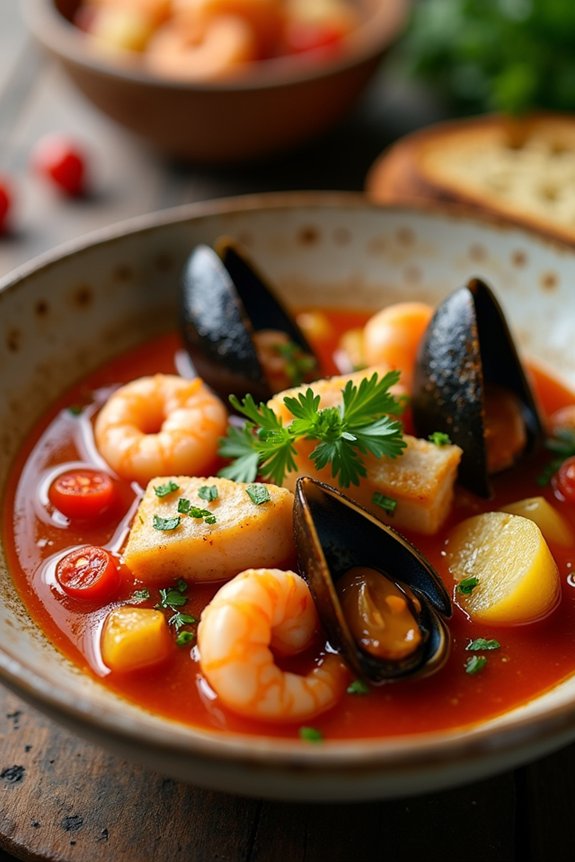
Greek Kakavia is a traditional fisherman’s stew, often referred to as the Greek version of the French bouillabaisse. This hearty dish brings together an assortment of fresh seafood, vegetables, and aromatic herbs, simmered to perfection, creating a warming and deeply flavorful stew. The word “kakavia” itself is derived from “kakavi,” which is the Greek word for the tripod cooking pot used by fishermen to cook their catch of the day.
Simple yet delicious, Kakavia is celebrated for its ability to showcase the rich and delicate flavors of the sea, often served with crusty bread to soak up the savory broth.
Perfect for a family meal or a cozy dinner party, Greek Kakavia is both versatile and easy to prepare. The stew is traditionally made with whatever fish is fresh and available, making it a great dish to make when you have a variety of seafood on hand. The combination of olive oil, lemon juice, and a hint of wine enhances the natural flavors of the seafood, while the addition of vegetables such as potatoes, onions, and tomatoes adds depth and texture.
This recipe serves 4-6 people and is sure to impress with its authentic Mediterranean flavors.
Ingredients for 4-6 servings:
- 2 pounds mixed fish (such as red snapper, cod, or sea bass), cleaned and cut into chunks
- 1/2 pound shrimp, peeled and deveined
- 1/2 pound mussels, cleaned and debearded
- 1/3 cup olive oil
- 2 large onions, chopped
- 3 cloves garlic, minced
- 4 large tomatoes, peeled and chopped
- 2 large potatoes, peeled and diced
- 1 carrot, diced
- 1 stalk celery, diced
- 1 bay leaf
- Salt and pepper to taste
- 1/2 cup dry white wine
- Juice of 2 lemons
- 1/4 cup fresh parsley, chopped
- 1 teaspoon dried oregano
- 4 cups fish stock or water
Cooking Instructions:
- Prepare the Base: In a large pot, heat the olive oil over medium heat. Add the chopped onions and garlic and sauté until they’re translucent and fragrant, about 5 minutes.
- Add Vegetables: Stir in the chopped tomatoes, potatoes, carrot, and celery. Season with salt and pepper, and add the bay leaf. Cook for about 10 minutes, stirring occasionally, until the vegetables begin to soften.
- Simmer the Stew: Pour in the white wine and let it simmer for a couple of minutes to allow the alcohol to evaporate. Then add the fish stock or water, and bring the mixture to a boil. Reduce the heat to low and let it simmer for about 20 minutes, or until the potatoes are tender.
- Add Seafood: Carefully add the chunks of fish, shrimp, and mussels into the pot. Cover and let the stew simmer for another 10-15 minutes, or until the fish is cooked through and the mussels have opened up.
- Finish and Serve: Stir in the lemon juice, fresh parsley, and oregano. Taste and adjust the seasoning if necessary. Remove the bay leaf before serving. Serve hot, accompanied by crusty bread to soak up the delicious broth.
Extra Tips:
When preparing Greek Kakavia, make certain that all seafood is fresh and properly cleaned to enhance the flavor of the stew. If you have access to a variety of fish, feel free to mix and match different types for a more complex flavor profile.
Additionally, it’s important not to overcook the seafood, as they can become rubbery. Keep an eye on the mussels and remove any that don’t open during cooking. To add a richer flavor, consider using homemade fish stock instead of water. Finally, serve the stew immediately to enjoy the full aroma and taste of this delightful Greek dish.
African Seafood Okra Stew
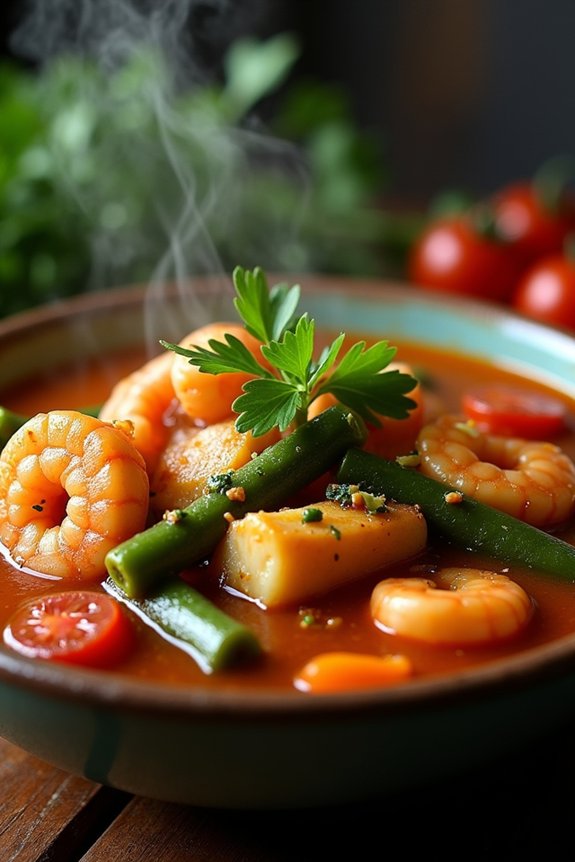
African Seafood Okra Stew is a rich, flavorful dish that brings the taste of the ocean to your table, paired with the unique texture and taste of okra. This comforting stew is perfect for any time of the year and showcases the diverse and vibrant flavors of African cuisine. The combination of seafood, tomatoes, and spices creates a delightful harmony that will leave you wanting more.
The stew can be served on its own or alongside rice or fufu, making it a versatile meal that can be tailored to your taste. This recipe serves 4-6 people, making it ideal for a family meal or a small gathering. The key to this dish is using fresh ingredients, especially the seafood, which can include a mix of fish, shrimp, and crab.
The okra not only adds a distinct flavor but also acts as a natural thickener, giving the stew its signature texture. With its vibrant colors and robust flavors, African Seafood Okra Stew is sure to be a hit at your dining table.
Ingredients:
- 1 pound fresh fish fillets (such as tilapia or cod), cut into chunks
- 1/2 pound shrimp, peeled and deveined
- 1/2 pound crab legs or crab meat
- 2 cups fresh okra, sliced
- 1 large onion, chopped
- 2 tablespoons vegetable oil
- 3 cloves garlic, minced
- 1-inch piece of ginger, minced
- 1 teaspoon ground cumin
- 1 teaspoon paprika
- 1/2 teaspoon cayenne pepper (optional, for heat)
- 1 can (14 ounces) diced tomatoes
- 4 cups fish stock or water
- Salt and pepper, to taste
- Juice of 1 lemon
- Fresh cilantro or parsley, for garnish
Instructions:
1. Prepare the Seafood:
Begin by cleaning the seafood. Rinse the fish fillets, shrimp, and crab legs under cold water. Pat them dry with paper towels. Season the fish and shrimp lightly with salt and pepper, and set aside.
2. Sauté the Aromatics:
In a large pot or Dutch oven, heat the vegetable oil over medium heat. Add the chopped onion and sauté until it turns translucent, about 5 minutes. Stir in the minced garlic and ginger, and cook for an additional 2 minutes until fragrant.
3. Spice it Up:
Add the ground cumin, paprika, and cayenne pepper (if using) to the pot. Stir well to coat the onion mixture with the spices, and cook for 1-2 minutes until the spices release their aroma.
4. Add Tomatoes and Okra:
Pour in the diced tomatoes and add the sliced okra to the pot. Stir to combine, and let the mixture simmer for about 5 minutes. The okra will start to soften and release its thickening properties.
5. Simmer the Stew:
Add the fish stock or water to the pot, and bring the mixture to a gentle boil. Reduce the heat to a simmer, and let it cook for about 10 minutes, allowing the flavors to meld together.
6. Cook the Seafood:
Gently add the fish chunks, shrimp, and crab to the pot. Stir carefully to confirm the seafood is submerged in the liquid. Cover the pot and let it simmer for 10-15 minutes, or until the seafood is cooked through and tender.
7. Final Touches:
Season the stew with salt, pepper, and lemon juice to taste. Stir well and remove the pot from the heat. Let it sit for a few minutes before serving to allow the flavors to meld further.
8. Serve:
Ladle the stew into bowls, garnish with fresh cilantro or parsley, and serve hot. It pairs beautifully with rice or fufu.
Extra Tips:
For the best flavor, use fresh seafood whenever possible. If fresh okra isn’t available, frozen okra can be used as a substitute. Adjust the level of cayenne pepper according to your spice preference—if you like it spicier, feel free to add more.
To enhance the stew’s depth of flavor, you can add a splash of coconut milk or palm oil. If using fish stock, confirm it’s low-sodium to control the saltiness of the dish. Remember, the longer the stew sits, the more the flavors develop, making it an excellent make-ahead meal.
Indian Fish Curry With Coconut Milk

Indian Fish Curry with Coconut Milk is a rich and flavorful dish that brings together the aromatic spices of Indian cuisine with the creamy texture of coconut milk. This comforting seafood stew is perfect for those who enjoy a blend of spicy and sweet flavors. The dish is typically made with firm white fish, which holds up well in the hearty sauce, while the coconut milk adds a luscious, velvety layer to the curry. Serve this dish with steamed rice or warm naan bread for a complete and satisfying meal.
The beauty of Indian Fish Curry with Coconut Milk lies in its simplicity and the use of readily available ingredients. The spices used in the curry are balanced perfectly to enhance the natural taste of the fish without overpowering it. The coconut milk not only adds richness but also moderates the heat of the spices, making it a dish that can be enjoyed by those who prefer a mild curry. This recipe serves 4-6 people, making it ideal for a family dinner or a small gathering with friends.
Ingredients:
- 1.5 pounds firm white fish (such as cod or halibut), cut into chunks
- 2 tablespoons vegetable oil
- 1 large onion, finely chopped
- 4 cloves garlic, minced
- 1-inch piece of ginger, grated
- 2 teaspoons ground coriander
- 1 teaspoon ground cumin
- 1 teaspoon turmeric powder
- 1 teaspoon garam masala
- 1/2 teaspoon red chili powder
- 1 can (14 oz) coconut milk
- 2 medium tomatoes, chopped
- Salt to taste
- 2 tablespoons lemon juice
- Fresh cilantro leaves for garnish
Cooking Instructions:
- Prepare the Fish: Begin by cutting the fish into bite-sized chunks. Pat them dry with a paper towel to remove any excess moisture, which will help them sear better in the oil.
- Sauté Aromatics: Heat the vegetable oil in a large pan over medium heat. Add the chopped onions and sauté until they become translucent and slightly golden, about 5 minutes. Add the minced garlic and grated ginger, stirring for another minute until fragrant.
- Spice It Up: Add the ground coriander, cumin, turmeric, garam masala, and red chili powder to the pan. Stir well to coat the onions with the spices, cooking for about 1-2 minutes until the spices are well-integrated and aromatic.
- Incorporate Tomatoes: Add the chopped tomatoes to the pan. Cook until the tomatoes break down and the mixture becomes a thick paste, about 5 minutes.
- Simmer the Curry: Pour in the coconut milk and stir to combine. Bring the mixture to a gentle simmer and season with salt to taste. Let it cook for 5 minutes, allowing the flavors to meld together.
- Cook the Fish: Gently add the fish chunks to the curry. Cover the pan and let the fish cook in the simmering sauce for about 8-10 minutes or until the fish is cooked through and flaky.
- Finish with Lemon and Garnish: Once the fish is cooked, stir in the lemon juice to add brightness to the dish. Garnish with fresh cilantro leaves before serving.
Extra Tips:
When making Indian Fish Curry with Coconut Milk, choose a firm white fish to ascertain it holds together well during cooking. If you prefer a spicier curry, you can increase the amount of red chili powder or add fresh green chilies for extra heat.
Be careful not to overcook the fish, as it can become tough; it should remain tender and flaky. This dish can be prepared ahead of time and reheated gently, allowing the flavors to develop even more. Serve with a side of steamed rice or naan to soak up the delicious sauce.

